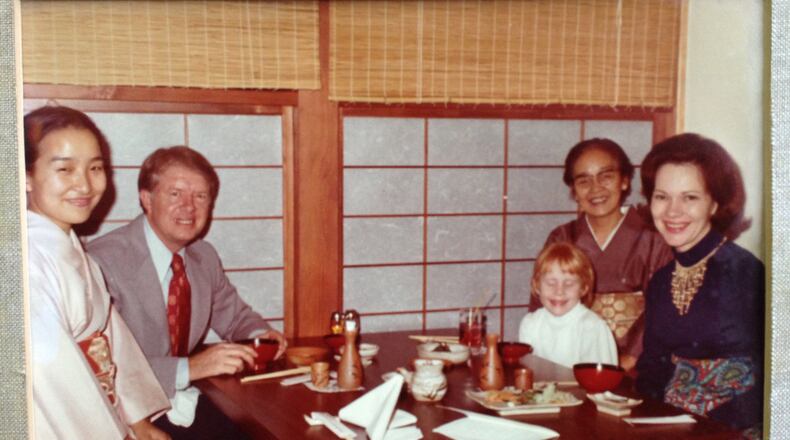“She was very ambitious. She comes from a family that lost everything in World War II, so starting from zero did not phase her at all.”
Sachi Nakato sat in the dining room of her family’s namesake Japanese restaurant, discussing how Nakato came to be. She was speaking of the restaurant’s early days, of her grandmother, Tetsuko Nakato, who founded the restaurant 45 years ago with help from her son, Kenzo, and daughter, Hiroe.
Credit: KENT D. JOHNSON / AJC
Credit: KENT D. JOHNSON / AJC
Tetsuko, who died in 1985, hailed from Saga, a city on the Japanese island of Kyushu. It was during a 1971 trip to the United States to visit Kenzo, who worked in Charlotte, N.C., that Tetsuko tasted the flavors of cities in the Southeast U.S. and declared to her kin that she wanted to move to Atlanta.
“She fell in love with the green space, Southern hospitality and the fresh air,” Sachi said.
Moving to Atlanta is one thing. Opening a restaurant is quite another. Perhaps that’s where the “very ambitious” part comes into play.
Tetsuko had worked in the hospitality industry — hotels, not restaurants. But by the time Tetsuko left her U.S. “tour” and returned to Saga, she already had a lease in hand for the space at 1893 Piedmont Road, formerly Italian restaurant Caruso’s. English translation: Come hell or high water, Tetsuko would open a Japanese restaurant in Atlanta.
Nakato opened its doors on Nov. 10, 1972.
A lot has happened since then. Like the unexpected role that the restaurant played in the early 1970s to shape the business landscape of the city — and even the state.
As Sachi tells it, the then-Gov. Jimmy Carter wanted to open the area to other countries. At the time, there was no Japanese embassy here (the Japanese consulate opened in Atlanta in 1974), so the restaurant unofficially filled that role, acting as intermediary for Japanese companies interested in entering the Georgia marketplace.
“They had no base to work off. They would have late-night meetings here and discuss how to bring their companies to the U.S.,” Sachi said.
On the culinary side, Nakato’s early days were as a restaurant built around eight teppan tables, where guests watched chefs grill, broil and pan-fry on an iron plate. Besides introducing diners to “exotic” teppanyaki-style cuisine, it also had a 25-seat tempura bar.
The sushi bar came around in 1974, when the restaurant was able to source quality raw fish — and when diners began showing an interest in sashimi and sushi.
There have also been expansions. By 1979, three Nakatos were up and running: the original in Atlanta, one in Charlotte and another serving the vacation crowd in Myrtle Beach, S.C.
These days, Nakato has five locations across four states, the latter two additions being a second spot in Charlotte and one in Springfield, Mo.
When Atlanta was chosen as the host city for the 1996 Summer Olympics, like many local businesses, Nakato geared up for the economic upturn, hoping to remain the go-to place for Japanese cuisine, even as competitors moved into the market. That was one reason it relocated to its current, bigger location on Cheshire Bridge Road in 1991.
» RELATED: Photos of 'Atlanta Sister Cities,' including Fukuoka, Japan
Fast-forward a generation. Sachi took over Nakato’s Atlanta operations in 2004. She was all of 23, fresh out of college, having graduated from Boston University. Scoff at the art history degree, but it is not as if Sachi was coming in green. She’d worked at Nakato since she was 12 years old, “running around the kitchen” to refill water glasses, plate desserts, calculate checks by hand and, of course, give Chef his sake nightcap when service ended.
Having managed operations for the past 13 years, Sachi reflected on how her job is different from what her mother, uncle and grandmother did.
“Their generation was to do ‘something right, and do it well, over and over again.’ I took it over and made sure people knew about it.”
That meant staying true to tradition but bringing Nakato into the 21st century: Give the restaurant a social media presence, move the reservation system from pen and paper to an online one, and replace an outdated point of sale system.
And that’s just the management side of things.
A year and a half ago, she upped the drink game at Nakato. The focus is on sake and the distilled Japanese spirit shōchū. Currently, nine staff members are certified sake advisers who have participated in courses on the history of sake, sake ingredients, production methods, serving and food pairing.
The 200-seat Nakato offers hibachi, sushi, traditional Japanese dining and tatami rooms — meditative, minimalist spaces characterized by low platform tables and straw mats.
“Our motto is ‘defining traditions since 1972,’” Sachi said.
She does not want to live behind the eight ball. Nor on anyone else’s terms.
“I want to make it mine,” she said of Nakato. “My restaurant is different, my job is completely different,” said Sachi, comparing how she runs the restaurant to what her mother and grandmother did back when.
In the last year, Sachi changed the print menu. Now, there are two menus: one in Japanese, the other in English. Both are photo-driven. “They help you know exactly what you’re getting,” she said.
Renovations are also in the works. Nakato is adding four teppanyaki grills. The restaurant’s entrance, bar, dining room and back rooms are all slated for improvements over the course of the next 18 months.
After laying bare the physical changes in store, Sachi laid bare her hopes for the big picture: “I don’t think we’ve pushed the envelope on the cultural side.”
These days, her mother is a sounding board. Phone calls go something like: “Mom, how did you do it? Which way should I go?”
“My mother understands it is different guests, different environment, food,” Sachi said.
Then, Sachi talked of needing a cup of coffee.
About the Author
The Latest
Featured







